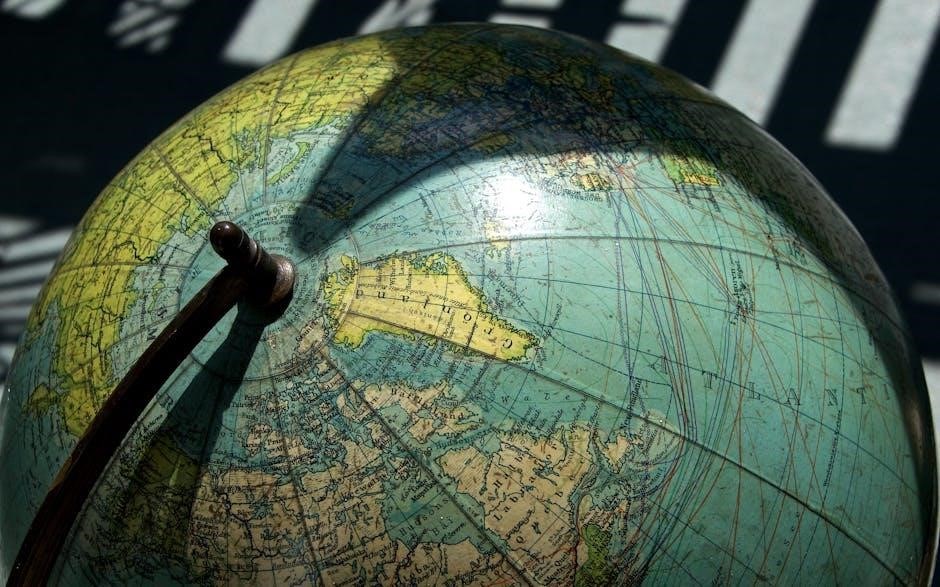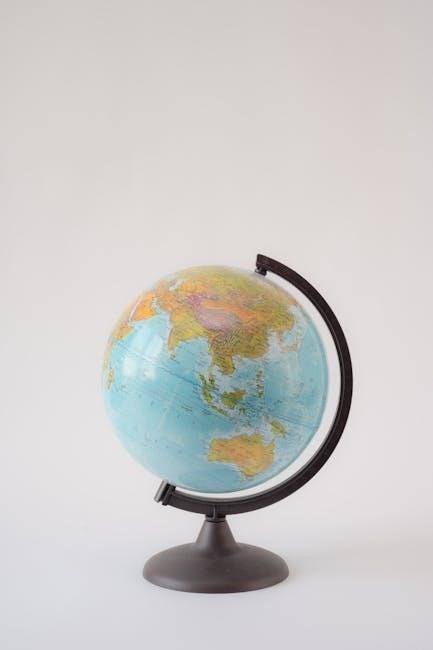
world map longitude and latitude pdf
Understanding Latitude and Longitude
Latitude and longitude are vital coordinate systems. They pinpoint locations on Earth. Latitude measures north-south position‚ while longitude measures east-west. These angular measurements‚ combined‚ create a global grid. This grid helps us to navigate and understand our world.
Definition of Latitude and Longitude
Latitude and longitude form a fundamental grid system used to define locations on the Earth’s surface. Latitude‚ often referred to as parallels‚ measures the angular distance‚ in degrees‚ minutes‚ and seconds‚ of a point north or south of the Equator‚ which is designated as 0° latitude. The North Pole is at 90° N‚ and the South Pole is at 90° S. Lines of latitude are circles running parallel to the Equator.
Longitude‚ also known as meridians‚ measures the angular distance east or west of the Prime Meridian. The Prime Meridian‚ an arbitrary line passing through Greenwich‚ England‚ is designated as 0° longitude. Longitude lines run from the North Pole to the South Pole. Unlike latitude lines‚ longitude lines are not parallel; they converge at the poles.
Together‚ latitude and longitude coordinates provide a unique address for any location on Earth‚ enabling precise mapping‚ navigation‚ and geographic analysis.
Importance of Latitude and Longitude

Latitude and longitude are critical for various applications‚ making them indispensable in modern society. Navigation relies heavily on these coordinates‚ enabling ships‚ airplanes‚ and even individuals with GPS devices to determine their precise location and chart courses accurately. Without latitude and longitude‚ global travel and trade would be significantly hindered.
Mapping and surveying depend on latitude and longitude to create accurate representations of the Earth’s surface. Geographic Information Systems (GIS) utilize these coordinates to analyze spatial data‚ supporting urban planning‚ environmental management‚ and resource allocation. Scientific research benefits from latitude and longitude in fields like climate science‚ geology‚ and ecology‚ allowing researchers to track phenomena‚ analyze spatial patterns‚ and understand the Earth’s complex systems.
In essence‚ latitude and longitude provide a universal language for location‚ fostering communication and collaboration across disciplines and borders‚ and underpinning a wide range of essential activities.
World maps display latitude and longitude lines. These lines form a grid. The grid allows precise location finding. Intersections provide coordinates. Coordinates pinpoint specific places. This system enables global navigation and understanding of spatial relationships.
Using Latitude and Longitude to Locate Places on a World Map
Locating places on a world map is straightforward with latitude and longitude. Latitude‚ measured in degrees north or south of the Equator (0°)‚ indicates how far a location is from the Equator. Longitude‚ measured in degrees east or west of the Prime Meridian (0°)‚ indicates the east-west position.
A world map displays these lines‚ forming a grid. To find a location‚ identify its coordinates. For example‚ (40°N‚ 74°W) represents New York City. The latitude (40°N) shows the city’s position north of the Equator‚ and the longitude (74°W) indicates its position west of the Prime Meridian.
Using this grid system‚ any place can be located. The intersection of the latitude and longitude lines pinpoints the exact spot. Maps often include reference points and scales. These assist in more accurate readings. Knowing the coordinates allows for easy location of cities‚ landmarks‚ and geographical features. This method ensures global positioning and navigation.

World Map with Latitude and Longitude
Different Projections of World Maps and their Latitude/Longitude Representation
World maps use projections to represent the Earth’s spherical surface on a flat plane. Different projections distort latitude and longitude differently. The Mercator projection‚ common for navigation‚ preserves angles but distorts area‚ especially at higher latitudes. This projection shows latitude and longitude as straight lines‚ simplifying navigation but exaggerating the size of polar regions.
The Gall-Peters projection‚ an equal-area projection‚ accurately represents the size of landmasses but distorts shapes. In this projection‚ latitude and longitude lines are still perpendicular‚ but shapes are stretched. The Robinson projection‚ a compromise projection‚ balances shape and area distortion. It curves latitude lines and keeps longitude lines mostly vertical.
Other projections‚ like the Winkel tripel‚ minimize distortion overall. Understanding these distortions is crucial for interpreting latitude and longitude on various world maps; Each projection serves different purposes‚ affecting how geographic information is perceived and used.
World maps displaying latitude and longitude are readily available in PDF format. These PDFs offer convenience for viewing‚ printing‚ and distribution. They provide accessible resources for educational and navigational purposes‚ useful for various applications.
Availability of World Maps with Latitude and Longitude in PDF
Numerous websites and online resources offer world maps with latitude and longitude lines in PDF format. These maps cater to various needs‚ from basic educational tools to detailed navigational charts. Users can easily find printable maps illustrating parallels of latitude and meridians of longitude. Many sites provide free downloads‚ while others offer specialized maps for purchase.
These resources often include various map projections like Mercator‚ Miller‚ or Robinson‚ each representing the Earth’s surface differently. Some PDFs focus on specific regions or themes‚ such as political boundaries or physical features‚ enhancing their utility. The availability of these maps in PDF ensures compatibility across devices‚ facilitating easy access for students‚ teachers‚ travelers‚ and professionals.
The widespread availability makes understanding global positioning and geographical relationships convenient. These digital maps are great for learning and practical use‚ providing valuable insights into the world’s coordinate system.

Latitude and Longitude in PDF Format
Advantages of Using PDF Maps
PDF maps offer several advantages over traditional paper maps or online interactive maps. Firstly‚ PDF files are highly portable and easily shareable across various devices‚ ensuring accessibility regardless of location or internet connectivity. This offline access is particularly beneficial for travelers or educators in areas with limited internet.
Secondly‚ PDF maps retain high image quality and detail‚ allowing for clear visualization of latitude and longitude lines‚ geographical features‚ and place names. They can be easily zoomed in without losing resolution‚ enabling close inspection of specific regions or coordinates.
Thirdly‚ PDF format supports annotations‚ highlighting‚ and markups‚ making it ideal for educational purposes or personal use. Users can add notes‚ mark locations‚ or measure distances directly on the map.
Finally‚ PDF maps can be readily printed‚ providing a physical copy for reference or display. This printability is crucial for activities like navigation‚ planning‚ or classroom instruction. These combined benefits make PDF maps a versatile and practical tool for understanding and utilizing geographical information.

Practical Applications
Latitude and longitude are used in navigation‚ helping determine precise locations. Education uses them to teach geography. They are also crucial for mapping and GIS‚ plus scientific research and location services‚ all relying on this coordinate system.
Using Latitude and Longitude for Navigation
Latitude and longitude are fundamental for navigation‚ providing a precise method to determine a location on Earth. Mariners and aviators rely on these coordinates to chart courses and navigate accurately across vast oceans and skies. By understanding their current latitude and longitude‚ navigators can pinpoint their position on a map or electronic navigation system‚ allowing them to make informed decisions about direction and distance.
Modern GPS systems use latitude and longitude to provide real-time location data. These systems calculate a device’s position by receiving signals from satellites orbiting Earth. This data enables users to navigate unfamiliar areas‚ track vehicles‚ and explore new destinations with confidence.
Whether using traditional charts or advanced digital tools‚ understanding latitude and longitude remains essential for safe and efficient navigation‚ ensuring travelers can reach their destinations accurately.
Practical Applications
Educational uses of Latitude and Longitude
Latitude and longitude serve as invaluable tools in education‚ fostering a deeper understanding of geography‚ spatial relationships‚ and global awareness among students. Through interactive exercises and map-based activities‚ educators can use these coordinates to teach students how to locate countries‚ cities‚ and landmarks around the world. This not only enhances their geographical knowledge but also improves their map-reading skills and spatial reasoning abilities.
Furthermore‚ exploring latitude and longitude can stimulate cross-curricular learning. Students can investigate how climate‚ culture‚ and economies vary across different latitudes‚ promoting a holistic understanding of the world. By analyzing real-world data and case studies‚ students can develop critical thinking skills and gain insights into the interconnectedness of global phenomena.